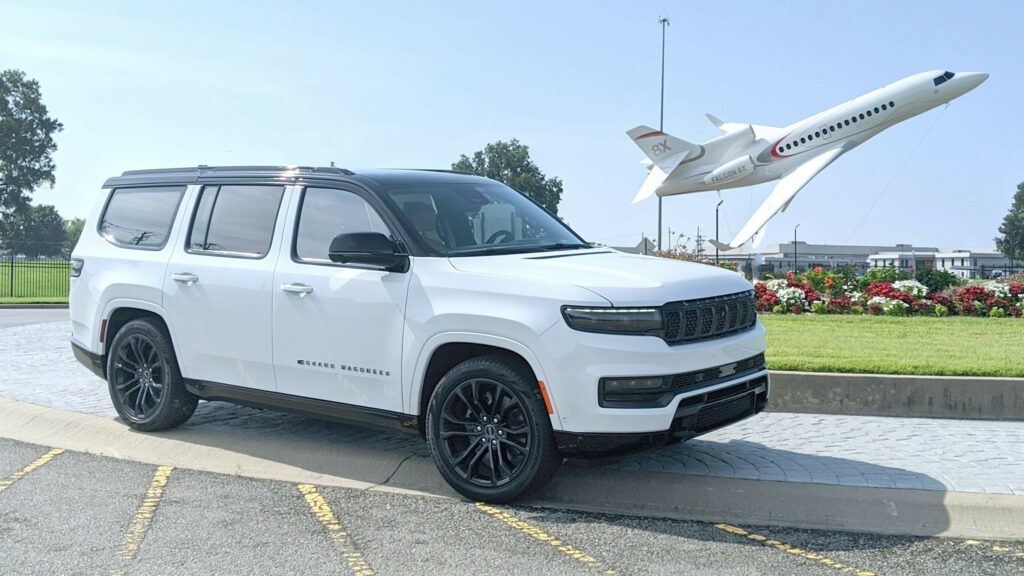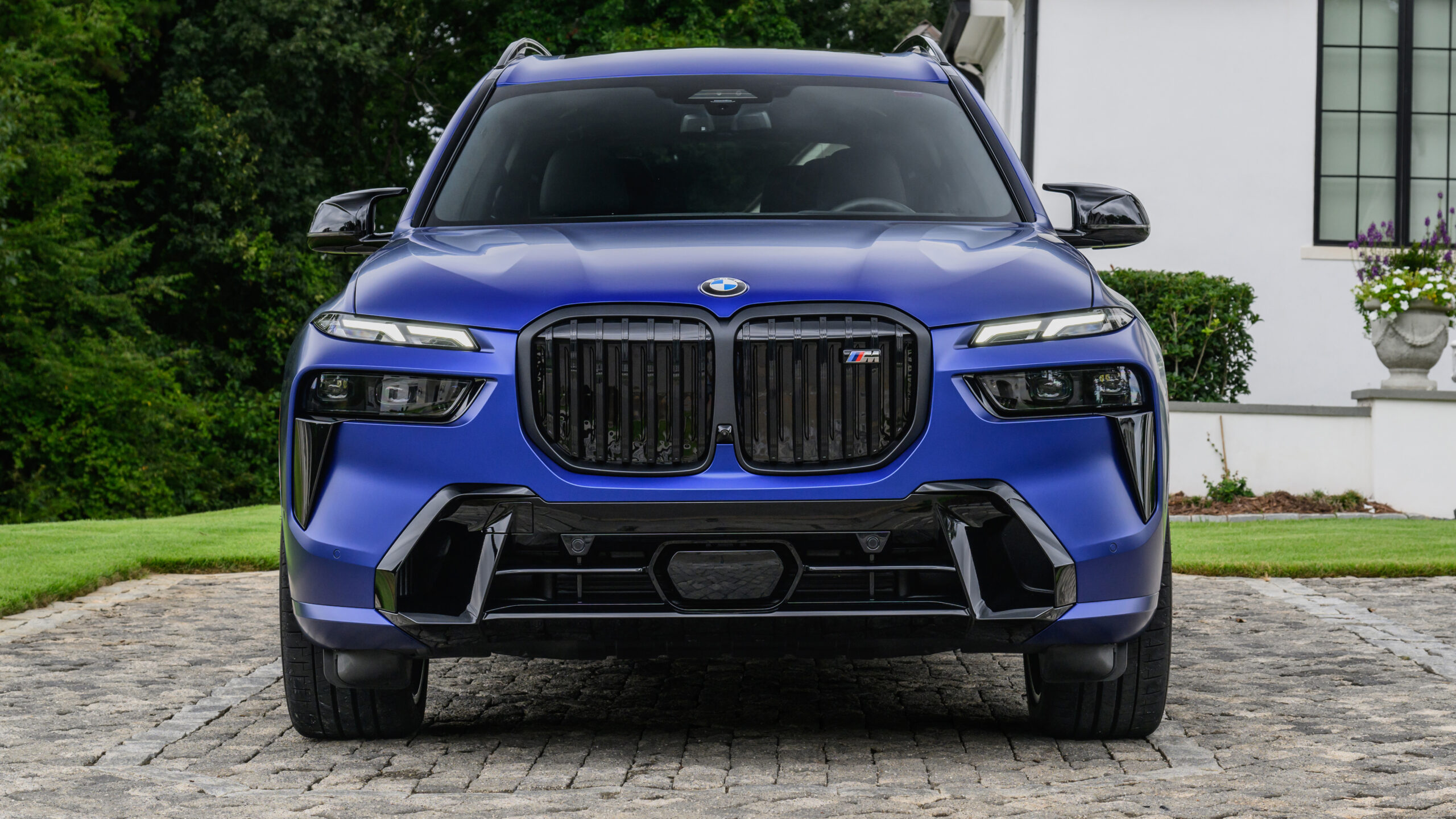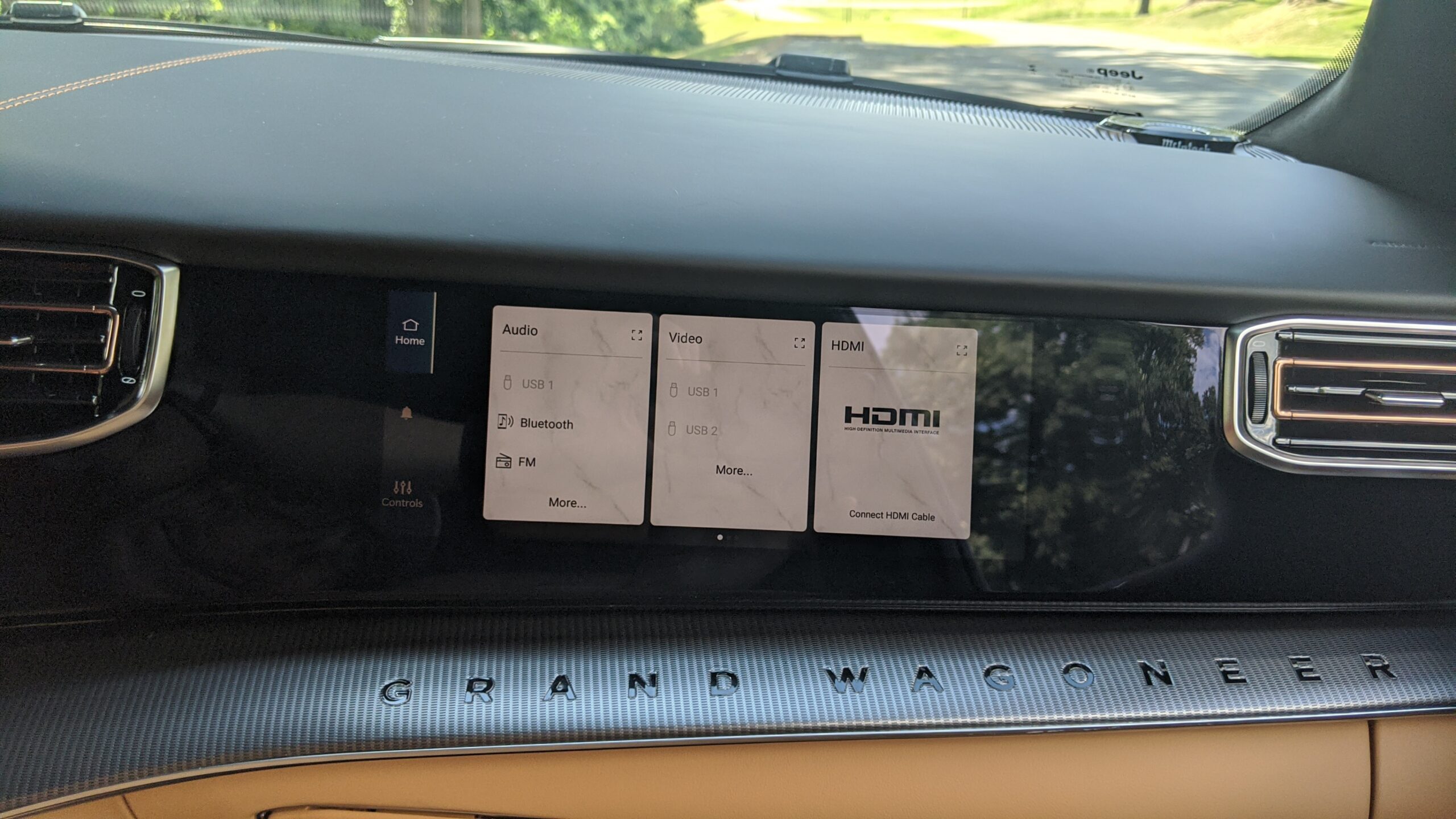Jeep returned the Grand Wagoneer, one of its most iconic nameplates, to the lineup just as a 2022 model and boy did this whale on wheels make waves. Upon arrival, many were displeased with the styling as it doesn’t call back to the original Wagoneer as loudly as some other modern retro designs in recent years. In addition, it started at $86,995 and for 2023 that figure is up to $91,140. That might be a tough pill for some to swallow for anything with a Jeep badge on it.
The rugged brand has long been known as a relatively inexpensive one that’s associated with reliability and fun more than rich leather and fancy finishes. The Grand Wagoneer is one major step toward changing that and it’s available in a slew of configurations starting at just over $91,000. In fact, Jeep also sells a far less posh version dubbed simply the Wagoneer. For a deeper dive into each trim, see our explainer here.
Over the course of a week, we tested the most expensive version of the Grand Wagoneer, the Series III Obsidian to find out just what one can get for $114,180 from an American manufacturer. Here’s all the good and bad, and why exactly we think the Grand Wagoneer is the closest thing to a private jet one can get for the open road.
The Best Kind Of Hurricane
Our Series III Obsidian trim of the Grand Wagoneer came with the brand’s latest and greatest powertrain consisting of a twin-turbocharged inline-six dubbed the Hurricane, an eight-speed automatic transmission, and four-wheel drive. The engine itself is good for 510 hp (380 kW) and 500 lb-ft (678 Nm) of torque and gets an EPA-estimated 17 mpg combined. When properly equipped, the Grand Wagoneer can tow up to 9,860 pounds (4,467 kg).
Those are serious figures but they only tell part of the story. The entire system incorporates an air suspension that can lower to enable easier entry to rise to the point where the Grand Wagoneer boasts some 10 inches (25.4 cm) of ground clearance. This three-row, seven-passenger behemoth can ford water up to two feet (61cm) deep. Try that in a BMW X7 or Audi Q8 and let us know how it turns out.
In addition, the 4WD system that underpins the Grand Wagoneer isn’t your average run-of-the-mill setup. It’s Jeep’s unique Quadra-Trac II complete with an electronically-locking limited-slip rear differential, a 2.72:1 low-range gear ratio, and multiple terrain modes. No, it won’t rock crawl like a Wrangler or even as well as the Grand Cherokee we tested last month, but it’s possibly the most all-around capable full-sized three-row SUV on Earth.
A Private Jet For The Parkway
Buyers who might initially balk at the price of this SUV need to have a seat in it before chafing too much. From the very first moments with the Grand Wagoneer, it’s clear that this isn’t your average Jeep product. In fact, the Jeep wordmark does not appear anywhere on the inside of this vehicle and only two very subtle places on the exterior (see if you can find them in the photos below). It’s the surfaces that initially give away the quality of the Grand Wagoneer.
The dash, the seats, the door cards, the steering wheel, and even the start/stop button all feature intricate details that exude luxury. Real metal, real wood, and real leather are everywhere and complemented by textured composites.
The only hint of cheap is the piano-black plastic whose manufacturer must have the best lobbyist in the business because it continues to exist in this and just about every other car despite numerous complaints from critics surrounding its propensity to gather fingerprints, smudges, dirt, and dust.
Review: Jeep Grand Cherokee L Offers Posh Off-Roading For The Whole Crew
Nevertheless, most will ignore that fly in the ointment when they turn on the massaging function in the front seats. Each chair features a plethora of adjustments including side-bolster firmness, seat bolster support, and thigh extension. Splitting the seats is a command-center style center console with a fixed infotainment screen measuring 12 inches.
Just below it is a 10.3-inch touchscreen that houses climate and comfort controls. Interestingly, it can stow itself away which reveals a space where a wireless charger resides along with a 12-volt power outlet, three USB ports, three USB-C ports, and an HDMI input. Above the first two rows of passengers is a huge panoramic sunroof.
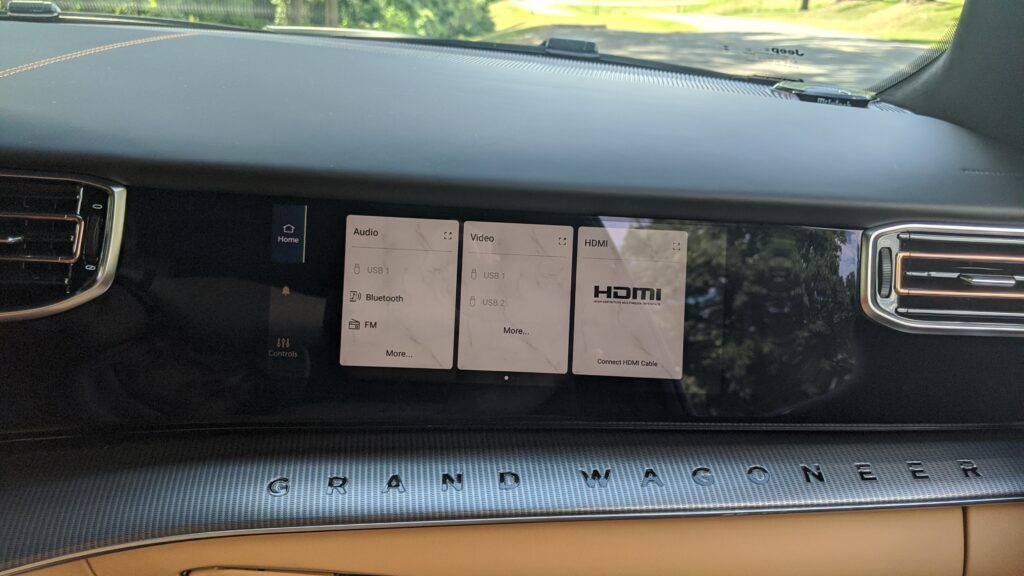
That HDMI input below can send media to the rear-seat entertainment screens or just to the front passenger display, a 10.3-inch touchscreen infotainment unit directly ahead of that seat. That screen enables the front passenger to load media for the whole family, watch something on their own, load a navigation route for the driver, or even hook up a video game console and play while they’re shuttled down the road.
They can also access the in-car and exterior cameras to get a better view of the world inside and outside of the Grand Wagoneer. Both front-seat occupants get access to the center console which, in most Grand Wagoneers, features a chill box that gets seriously cold seriously fast when on. Buyers can instead spec a lockable storage space there should they prefer it.
The rear-seat entertainment screens are largely fixed in place on the back of the front-seat headrests but they do swivel to accommodate different viewing angles. Each one needs a WiFi connection to work properly but with it, they have native access to streaming services like YouTube, Netflix, Disney+, and more. There are even clever vehicle apps like “Are we there yet” which allow rear-seat passengers to monitor how long it’ll be until the vehicle reaches a destination set in the navigation.
Second-row passengers also enjoy a third rear-seat touchscreen between the captain’s chairs to control the climate and heated seat functions. They also have access to their own center storage area, cupholders, and individual USB power ports to keep things charged up on the go. Both seats also benefit from manual adjustments that move the seat forward or back and allow for some reclining.
That’s almost comical when one considers that the third row almost has it better with power-reclining seatbacks. There are cupholders, climate vents, and a pair of USB power ports for each outboard third-row passenger too. Oh, and just for good measure, there’s a static sunroof for the third row too. Put simply, there’s not a bad seat in the Grand Wagoneer no matter how long the trip is.
Every passenger also benefits from a stunning McIntosh sound system that is the only one in my life that was so good to listen to that I resisted getting out at destinations just to hear songs finish. In case all of that luxury isn’t enough, there’s room behind the third row for storage too. The version we tested had 28.4 cubic feet of cargo room behind the third row. There’s an even larger version of the Grand Wagoneer, the aptly named L which has 44.2 cubic feet back there. If that’s not enough, don’t forget that this thing can tow just about anything you might need.
Piloting A Jet For The Road
Finally, we’re to the point where big SUVs almost always seem to disappoint: the way they feel to drive. Somehow the Grand Wagoneer manages to eschew that stereotype though. I personally daily drive a Ford Flex Limited specifically for its ability to combine three-row seating with what is nimble handling for the class. The Grand Wagoneer might be this automotive generation’s version of that.
No, it’s not as sharp as something that’s lower and lighter like the Flex, but considering its weight and higher center of gravity it’s practically a ballerina on 22-inch wheels. It soaks up bumps over the road but also manages to feel stable and easy to direct accurately. The steering feel is tight and weighty but communicative and clear about where this beast is pointed.
The pedals are very linear in their performance. The somewhat steep brake pedal learning curve we experienced in the Grand Cherokee is gone in the Grand Wagoneer which is great considering that some versions weigh over three tons. Don’t get me wrong, this isn’t anywhere near as sharp as a BMW, Audi, or Mercedes at the top of the on-road performance spectrum.
No car is perfect and the Wagoneer isn’t either. The biggest issue with it is one that it simply can’t avoid given that weight: poor fuel economy. Over the course of seven days with the Grand Wagoneer, I drove it in the city, on the highway, and over a total of 245.9 miles. During that time, I averaged just 12.1 mpg. Suffice it to say, I didn’t attempt to hypermile this monster but that’s still a very low figure. Again, this is like a private jet for the road and those who own private jets probably won’t care too much about getting such poor fuel economy and they can afford it without much consideration.
Punching Up Into A New Segment
Jeep clearly wants to make the Grand Wagoneer its own segment of the brand. That’s not easy and requires a great deal of effort for two main reasons. Firstly, rivals like BMW, Mercedes-Benz, Cadillac, and Lincoln have many years of building brand recognition and loyalty. Secondly, no matter how high or low a brand prices its offering, the content has to meet or exceed expectations.
In our eyes, the Grand Wagoneer does that in almost every way. The only three-row SUVs that can actually go toe to toe with it in terms of luxury, on-road handling, and off-road capability are from Land Rover and the truth is that Jeep has pulled off a more luxurious interior with the Grand Wagoneer. Every other rival is missing a piece of that triangle. In addition, every Wagoneer and Grand Wagoneer comes with three full years of complimentary maintenance.
The one big caveat is that many rivals offer a much more performance-based on-road experience with one trim or another. In truth, that’s where the vast majority of all three-row SUV buyers will spend their time. For those who plan to go off-road at all, we’d recommend the Grand Wagoneer.
Cleared For Takeoff
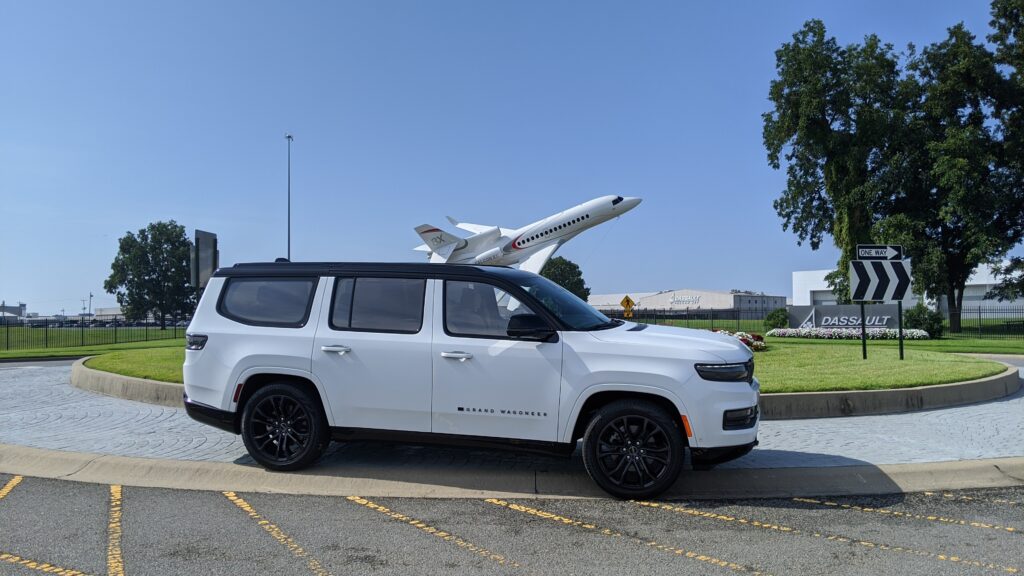
Here’s the thing about a private jet. Most people can’t really tell one from another but those who can afford them know what’s what. The Jeep Grand Wagoneer is a sincerely excellent three-row luxury SUV for the money but to make a real impact it’ll need to snatch away market share from big brands with an even bigger presence in this space.
Can it do that at this stage in the game? Buyers will need to accept trade-offs like sub-par fuel economy, less than world-class on-road behavior, and possibly an exterior design that’s less appealing than some rivals. If they do accept those caveats they’ll enjoy a world-class interior and the features that come with it.




